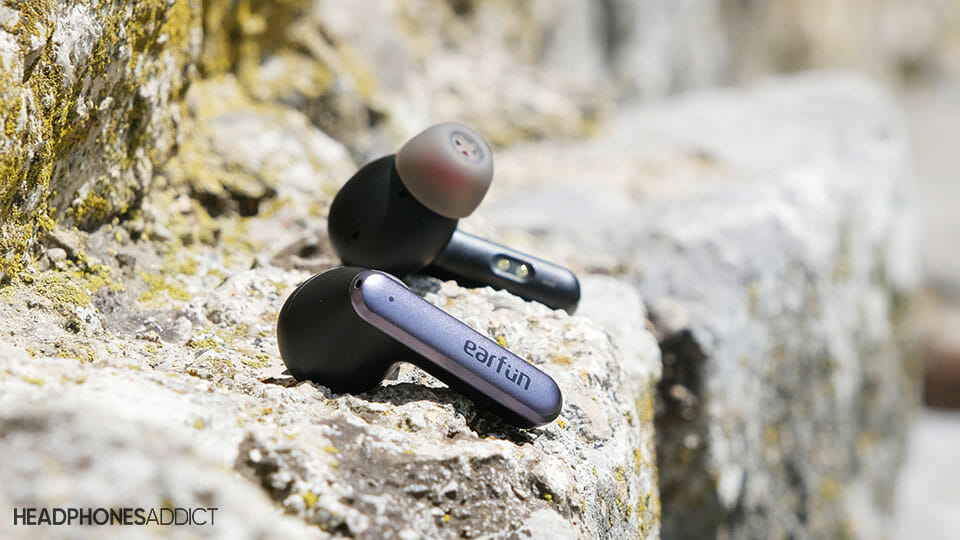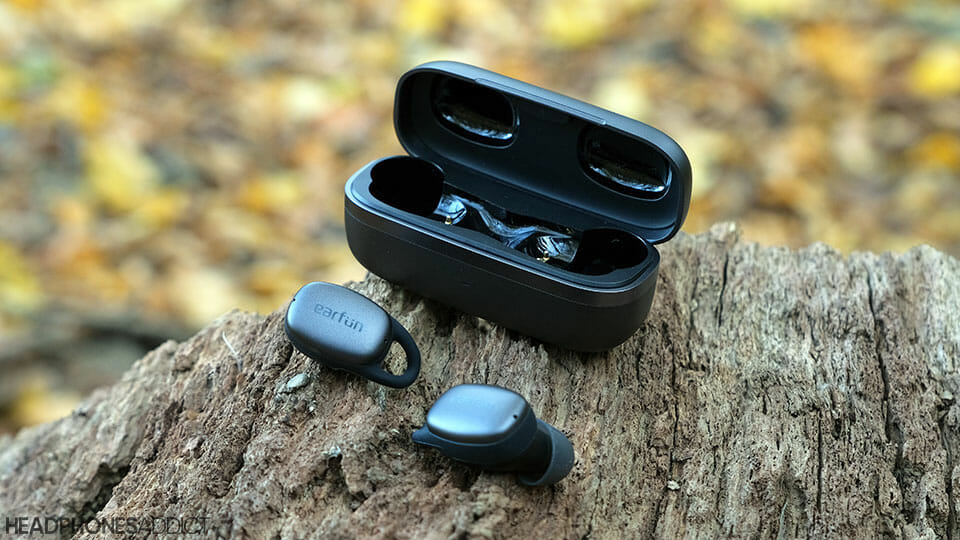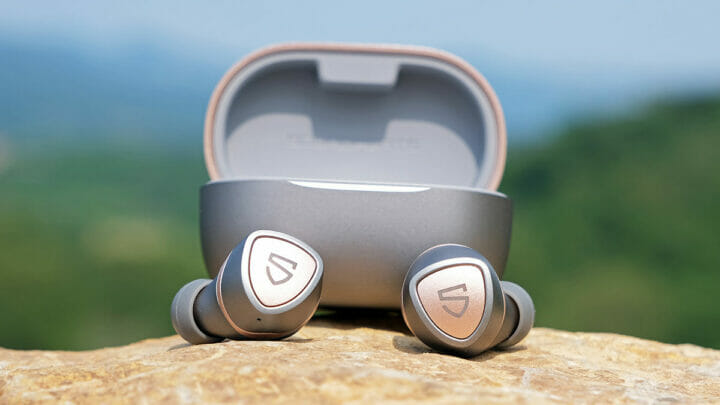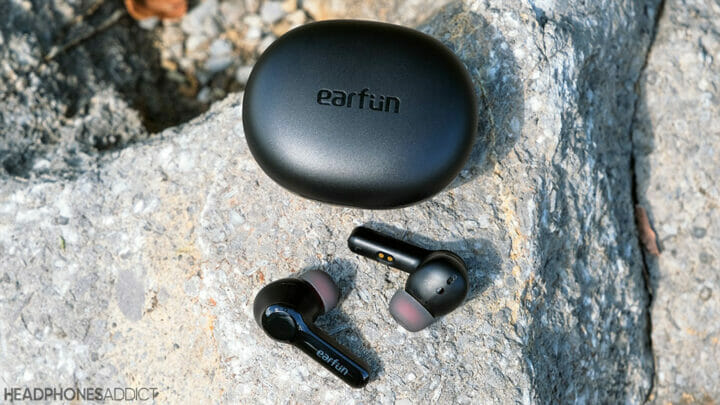
EarFun Air S are a great addition to the under $50 market, with a pleasant sound, tons of solid features, and impressive comfort and stability. There are just a few tiny problems.
If you’re looking for a great pair under $50, look no further. While highly recommended Anker Soundcore Life A1 sound livelier, they lack many valuable features of the EarFun Air S.
Most noticeably, the Air S come with a solid ANC and a surprisingly full-sounding transparency mode.
Furthermore, earbuds feel feather-light and remain comfortable for hours. In combination with excellent stability, you can use them for light workouts.
Finally, EarFun Air S sport a good sound quality (that gets slightly better with custom EQ). The sound signature closely resembles the one from the earbuds we’ve already tested. More on that later.
However, some kinks might make your user experience a bit annoying.
Find out what I’m talking about in the full review below.
UPDATE 08/31/2022: Added info about the EarFun app alongside my custom EQ for the best sound. I have also corrected the rating.
- Good, smooth sound
- Comfortable fit
- Stable enough for workouts
- Decent active noise cancellation
- Good transparency mode
- Multipoint, game mode, & aptX
- Companion app with custom EQ
- Somewhat average battery life
- Slightly too sensitive controls
- Bass can sometimes muddy the sound
Sound

A much tamer sound compared to other EarFun earbuds, with balanced mids, and relatively smooth treble, whereas the bass stays punchy and deep.
EarFun Air S Sound Comparison
Learn how to understand sound comparisons.
While most EarFun earbuds sound energetic and V-shaped, the EarFun Air S take a smoother, darker route.
Bass: Deep and slightly too extended
Lower frequencies have the most attention. The entire region is boosted, which adds a ton of warmness to the overall sound.
However, that makes the bass less controlled and can occasionally veil the midrange. Thankfully, it happens rarely and on specific tracks.
The bass delivers a good punch and decent speed. While you can listen to faster music genres, quick double pedal work can get muddy and lost in the mix.
That being said, the bass boost still isn’t overdone. Sure, it isn’t for purists, but if you plan to use them outdoors, the extra punch can come in handy.
EarFun Air S Frequency Response

Midrange: Balanced but a bit muted
Overall, the midrange frequencies are reasonably balanced but not as clear as more premium models, EarFun Free Pro 2 and EarFun Air Pro 2 included. Which is to be expected.
The tuning highly resembles TOZO T10, budget true wireless earbuds below $30. In comparison, the EarFun Air S are a tad more detailed.
However, the mids still feel a bit muted due to the presence of boosted bass.
Treble: Could use a bit more energy around 10kHz
Here, the tuning is again similar to the TOZO T10. The lower portion of the treble is slightly recessed, whereas the upper one is boosted. That gives the sound a nice shimmer.
However, a bit of boost around 10kHz would add some airiness to the sound, making it less congested due to the bass.
Cymbal crashes can sound a bit splashy on busy tracks, especially in the metal genre. On calmer tracks, splashiness isn’t an issue.

The soundstage is small yet roomy enough not to make the music congested.
Fortunately, the imaging is pretty solid, which helps with the small soundstage. It places the sounds around your head with good accuracy.
In conclusion, EarFun Air S pleasantly deviate from the rest of the EarFun earbuds (especially the Free 2 model), which are slightly too excited.
However, you still have to like strong bass to enjoy the earbuds. And to some, they might be a bit dull.
Nevertheless, most casual users will be satisfied with the overall sound performance.
Comfort & Fit

A full-day comfort due to ergonomic, lightweight design, and impressively stable fit. If only earbuds wouldn’t bounce so much in your ears.
EarFun Air S sport a stem design, much like Apple AirPods. Oval-shaped housing fits nicely into your ears without creating any pressure points.
Since earbuds are so lightweight, they sit comfortably in their place during long listening sessions.
To ensure a perfect fit, you get 4 pairs of silicone ear tips inside the box. The material EarFun is using for ear tips also provides a secure grip during movement.

Regarding stability, the Air S feel rather strange. You constantly think they’re about to fall out of your ears, but they never do, no matter how hard you shake your head.
Not even vigorous shaking moves them out of place. And the best part, they never lose the seal, which would mean noticeably worse bass performance.
On the other hand, the reason why I’m not giving EarFun Air S full rating is in-ear bouncing.
While every earbud bounces up and down when you walk, EarFun earbuds tend to make this sensation especially obvious. It seems like ear tips scratch your ear canal, which you can hear distinctly.
It sounds like a minor thing, but if you use earbuds primarily for outdoor walking, this might get annoying over time.
Durability

EarFun Air S come in an all-plastic design that feels relatively durable, on top of an IPX5 rating that protects the buds from water splashes.
Holding the Air S in hand doesn’t scream premium quality. The case and buds are made of decent-quality plastic and weigh very little.
Thankfully, they’re no visible weak points. Earbuds feel solid, and I don’t see them breaking in half anytime soon.

Furthermore, the plastic feels strong enough to easily sustain a few drops, although you might end up with a scuffed earbud.
An IPX5 rating helps keep sweat and splashes of water out from the internals. While you can probably take them under the shower if you want to, don’t let them drop into the water.
The charging case quality is good for the price. I’ve seen worse from SoundPEATS Sonic.
The lid shuts down securely and never accidentally opens. However, the lid’s plastic is relatively thin, so it might break or crack if you drop the case on the floor.
Last but not least, like with EarFun Free Pro 2, the Air S also comes with an earbud cleaning tool. The included instructions tell you how to properly clean your earbuds if they get covered in gunk and ear wax.
Overall, durability is pretty solid and in line with the price.
Battery

The battery life with ANC enabled lasts for 5 hours and 1 minute, which is about average. The charging case holds another 20 hours of juice and can be wirelessly charged.
EarFun Air S Battery Comparison

EarFun Air S are moderately generous with the battery life, having somewhat average duration compared to other true wireless earbuds.
EarFun Air S battery test:
- 5h 1min (ANC on)
- Around 6 hours (ANC off)
They still manage to beat the Free Pro 2 model, which only lasts for 4.5 hours, but can’t reach the Air Pro 2 model, which works for slightly more than 6 hours on a single charge.
Thankfully, the Air S earbuds charge quite fast:
- 1 hour to charge the earbuds from 0-100%
- 2 hours to charge the charging case (via USB-C)
- 3.5 hours to charge the case (via Qi wireless charger)
The charging case holds another 20 hours of playtime if you’re constantly using ANC. Otherwise, if you leave ANC off, there should be enough for extra 30 hours inside the case.
Features

For affordable earbuds, EarFun Air S don’t skimp on extra features. If only touch controls would be more responsive.
The price doesn’t mean a product must be light on features. EarFun Air S offers more than enough for a casual user.
You get a decent ANC, effective transparency mode, and a game mode that reduces latency. Moreover, Android users can enjoy the aptX Bluetooth codec.
The top of the stem is touch-sensitive. The sensitivity is pretty high, so you constantly activate a “volume up” gesture when putting the buds in your ears.

Another small annoyance is that you have to double or triple tap them at a specific speed. If you’re too fast, they’ll register a single tap.
Controls are fixed, so you can’t customize them.
EarFun Audio app
It was pointed out to me that the companion app for the EarFun Air S exists, despite no mention on the box or in the user manual. And it does exist! It’s called EarFun Audio, and it offers a few useful features.
The one that comes in the handiest is the custom equalizer. It’s only 3-band, but it still helps to make the sound of the Air S even more balanced throughout the frequency range.

Another great thing about having the app are firmware updates. Unlike with the EarFun UBOOM L Bluetooth speaker, where you have to perform firmware updates manually, here the app does them for you.
Microphone Quality
EarFun Air S call quality is good enough for making quick phone calls.
EarFun Air S Microphone Test
Your voice will sound slightly muffled and lacking clarity. However, for the price, the performance is more than acceptable.
Even with loud background noise, the voice quality stays the same. Your voice remains perfectly understandable, which is the most important thing.
Still, use these earbuds only for shorter calls, and pick something else for longer ones.

Noise Isolation

Due to the gentle fit of the ear tips, the earbuds don’t block much of the ambient noise.
If you seek earbuds that don’t entirely rely on active noise cancellation to reduce background noise, then EarFun Air S aren’t the ones for you.
It seems like ear tips don’t seal the ear canal enough to block outside noise from coming inside.
The noise reduction is minor, only slightly muting the midrange and high frequencies while letting through most of the lower ones.
For any substantial reduction, you’ll have to use active noise cancelling.
Noise Cancelling

Active noise cancellation does a great job with lower frequencies but struggles with the rest of the spectrum.
EarFun Air S Active Noise Cancelling Test
It shows that EarFun Air S model is affordable and uses a lower-tier ANC chip to process out the noise.
As a result, active noise cancelling works primarily on the lower end, eliminating engine noises and hum from air conditioning.
On the other hand, earbuds leave most of the midrange and treble intact.
Compared to the slightly more expensive EarFun Free Pro 2 and EarFun Air Pro 2, the latter do a much better job with ANC.
Still, I would prefer them over TaoTronics Soundliberty P10 Pro, which are selling for a similar price.
Another thing worth mentioning is that you don’t hear any static noise or shimmer when you turn on the ANC. Even more expensive offerings like 1MORE Evo suffer from it.
How is the ambient sound mode?
The transparency mode is surprisingly great. It captures surrounding noise fuller than Sony WF-1000XM4, a flagship from Sony.
Of course, Sony’s make the vocals much cleaner, which is excellent if you want to have a conversation without taking the earbuds off.
Still, you can easily use the EarFun Air S’ transparency mode to make quick replies to people nearby.

Bluetooth

While the Bluetooth range is only average, the EarFun Air S offers multipoint, aptX, and Game mode for a lower audio delay during mobile gameplay.
EarFun Air S come with the latest Bluetooth version 5.2 tech, providing a reliable connection when a transmitting device is nearby.
I haven’t experienced random audio stutters during testing, which would otherwise sour the listening experience.
As for the Bluetooth range, it’s slightly above average, if I’m being generous. The audio starts cutting off at around 50 feet, with two brick walls between the buds and the audio device.
While that isn’t among the best out there, it’s still more than good enough to walk freely around the house.
How is pairing?
- The first pairing initiates when you take them out of the case.
- To pair the earbuds to any other device, you have to place them in the charging case and hold the button inside for 3 seconds or until you see a white flashing LED.
Since they support multipoint, they’ll remember the last two connected devices and switch between them simultaneously.

What Bluetooth Codec Do They Use?
EarFun Air S use SBC, AAC, and aptX Bluetooth codecs. The latter is relatively uncommon in this price range since it doesn’t bring that many benefits.
Nevertheless, earbuds work perfectly with Android, iOS, and Windows operating systems.
Is There an Audio Lag?
The delay is hardly visible thanks to Game mode, which reduces the latency below 100ms. YouTube is completely in sync, and the performance should satisfy all but the most demanding mobile gamers.
However, there is a couple of the second delay when resuming the playback or switching between two connected audio devices.
Usually, the competition starts playing about a second after selecting them as the main audio playback device. EarFun Air S take at least two seconds, if not 3, to wake up and start playing.
Should You Get EarFun Air S?

If you’re looking to get full-featured earbuds at an affordable price, EarFun Air S might be perfect for you. They’re yet another EarFun product that pushes the price/performance ratio to the extremes.

Earbuds sound good, are very comfortable and nicely stable during activities, and have decent active noise cancellation and great transparency mode.
Furthermore, they support multipoint, aptX, and game mode and can wirelessly charge—a ton of extras for such a small price.
Of course, they aren’t perfect. Battery life is only average, and they tend to produce scratchy noise when inside your ear. Touch controls can also be a bit finicky to master.
Nevertheless, these earbuds are a sensible pick if you’re on a tight budget. They’re also the best AirPods alternative in this price range.
If you don’t mind the features, SoundPEATS Sonic offer a slightly more balanced sound. And if you want something even cheaper, then TOZO T10 is a perfect alternative.
How do EarFun Air S compare to the competition?
- As one of the rare examples in this price range, they offer a decent ANC.
- As well as ambient sound mode, which works really well.
- They’re equally if not more comfortable than the competition.
- The charging case offers Qi wireless charging.
- They offer a companion app, which is very rare in this price range.
- But the battery life is on the shorter side compared to the competition.
- The bass can sometimes muddy the sound.
EarFun Air S Alternatives
SoundPEATS Sonic
Sonic have a more balanced sound with only a substantial boost in sub-bass. That makes the sound less muddy compared to the Air S.
However, the features are pretty bare bones. Even the build quality feels cheaper.
On the other hand, the battery life lasts 14 hours on a single charge, which is more than twice as much as the Air S.
TOZO T10
A cheaper alternative with a similar sound signature but slightly worse performance.
While the earbuds feel great and comfy, the charging case is too bulky. At least it supports Qi charging.
The T10 don’t support any other extra features like the Air S. But they still offer a lot for the price.
EarFun Free 2
The Free 2 model is like a weird anomaly in the lineup, with strange, lackluster sound quality with too much sparkle.
Other than that, the earbuds feel comfortable and provide useful features, like touch controls, Qi charging, low latency mode, and aptX.
They’re even more durable than the Air S, sporting an IPX7 rating.
What’s in the Box?

- EarFun Air S true wireless earbuds
- Charging case
- USB-C charging cable
- 4 pairs of silicone ear tips (XS, S, M, L)
- Swab with instructions on how to clean the earbuds
- User guide
Specifications
| Type: | True wireless |
| Connection: | Bluetooth 5.2 |
| Back design: | Closed-back |
| Drivers: | n/a |
| Frequency range: | n/a |
| Impedance: | n/a |
| Weight: | 52g (with case) |
| Mic & Controls: | Yes |
| Water resistance: | IPX5 |
| Battery life: | 5h + 20h (ANC on) |
| Charging time: | 1h + quick charge – USB-C & Qi wireless |
| Active noise cancelling: | Yes |
| Bluetooth codecs: | SBC, AAC, aptX |
| Wireless range: | 50 feet (15.2m) |
| Microphone: | Total of 4 mics |

From a childhood fascination with sound, Peter’s passion has evolved into a relentless pursuit of the finest headphones. He’s an audio expert with over 5 years of experience in testing both audiophile and consumer-grade headphones. Quote: “After many years, I can confidently tell which headphones are good and which are terrible.” Find his honest opinion in his reviews.












15 Comments
Review 1
They only have 4 mics, not 6 as it says in the last table.
Peter Susic
You’re correct, thank you. Fixed. 😉
Anthony
The website says that you can use the airfun app which provides some basic EQ
Peter Susic
Thanks for letting us know!
We’ve added an update about the EarFun app and also made our custom EQ for the EarFun Air S. 😉
Mark Tamashiro
when trying to apply coupon EFAIRS25, Amazon says promotional code is not valid 🙁
Matija Ferjan
Thanks for letting us know Mark.
We got this info from EarFun directly. Just sent them an email asking what’s up.
This is the code: EFAIRS25
This is the Amazon link: https://www.amazon.com/dp/B0B3R6NGJ6
Matija Ferjan
Here’s the new 15% off coupon: EFAIRS52 (Exp. Sept. 30)
Viktor
You say you would pick something else for longer calls…. What would be your choice for that use case?
Matija Ferjan
For the latest earbuds with a quality microphone, check this guide: https://headphonesaddict.com/best-earbuds-with-microphone/
Yisroel
Since these only have 4 microphones are they worse in quality then the air pro 2’s or air SV’s? They are similarly priced, so that might be a good reason to choose one over another. BTW do any of these have better sound quality? Thanks
Peter Susic
I assume you’re interested in call quality? If so, I would personally pick the Air S for calls over Air Pro 2. Although they’re pretty similar, the Air S perform slightly better in noisier environments. You can hear my microphone tests in the reviews of both models. Unfortunately, I can’t speak for the Air SV since I haven’t test them.
Regarding sound quality, the Air Pro 2 are a bit more dynamic and sparkly, but the Air S can sound more balanced when using in-app EQ.
TiagoB
Awesome review you’ve made!
Do you have a new (still valid) coupon?
Thanks!
Matija Ferjan
Thanks! 🙂 Sorry, the previous coupon has expired, and don’t have a new one right now. But we will update the article when new coupons are up.
Sean
It looks like the app updated to a 6 band eq what would you recommend now for settings?
Peter Susic
I opted for the following settings:
63Hz = -7dB
8kHz = -4dB
15kHz = +1dB